The LG G3 Review
by Joshua Ho & Anand Lal Shimpi on July 4, 2014 5:00 AM EST- Posted in
- Smartphones
- LG
- Mobile
- Laptops
- G3
Rear Camera Performance
Spatial Resolution
We'll start by measuring the rear facing camera's ability to resolve fine details by shooting at an ISO12233 test target. For now we'll be looking at horizontal and vertical resolution using the sagittal and tangential lines in the upper right of the center of the test chart:
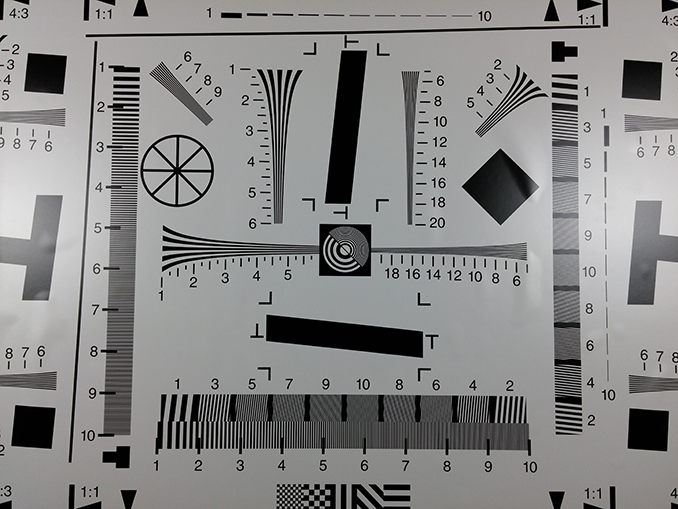
ISO 12233 Test Chart Captured by the LG G3
The gallery below has links to the original chart captures for all of the phones compared in this review:

The G3 does a good job of resolving fine details. The Galaxy S5 is a bit better, but the G3 is much better than its other competitor: the HTC M8. There's not really any improvement here over the G2 thanks to LG's sensor re-use. We do see a bit of difference in LG's white balance at work but in terms of usable resolution, the G3 performs quite similarly to the G2. There are some slight differences in how aliasing appears in the G3's chart but not substantial enough to make a big deal about.
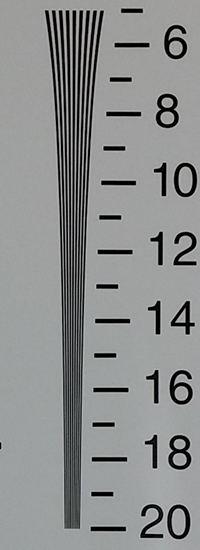
The tangential crops tell a similar story. The G3 doesn't really move the needle compared to the G2, but that's not bad at all. Compared to modern Android flagships, the G3's ability to resolve fine details is quite competitive. I actually wonder if somewhere in the 10 - 13MP range may be the sweet spot, perhaps with slightly larger pixels.
Color Reproduction
LG continues to strike a good balance between vibrant and accurate colors. When properly exposed, the G3's color performance is solid. Grayscale reproduction also looks good. There's a bit more noise than I'd like to see in the swatches but overall the G3 does a good job in this test:
Lab Scenes
In our light controlled lab scene we really see how little has changed between the G2 and G3 cameras. The G2 had a longer capture period at 1/30s compared to 1/40s on the G3, but the results are largely similar. The G2 was a very strong performer, as is the G3.
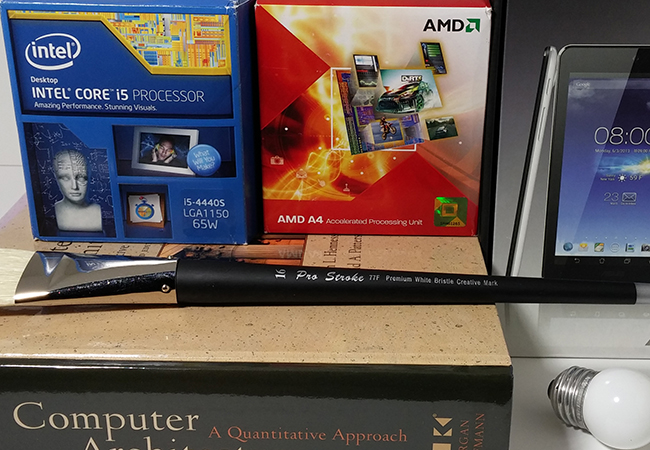
Low light performance was a strength of the G2 due to whatever binning or exposure combining LG did in low light conditions. The G3 continues the trend, although it seems to have a faster shutter speed resulting in a slightly darker scene.
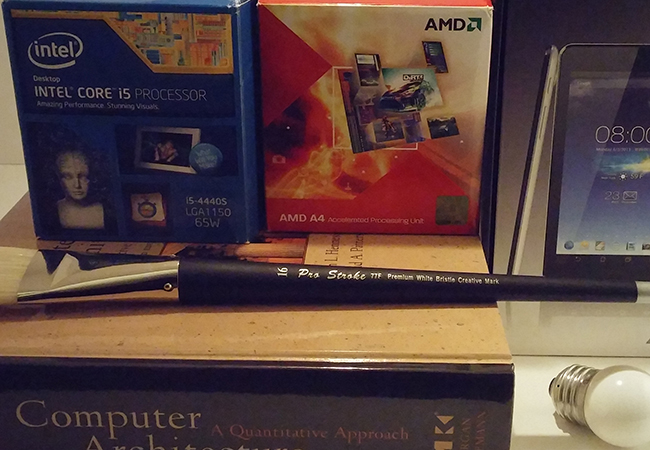
Outdoor Scenes (Night)
Next we transition to some shots on location. First up is the same night shot of a storefront that we used in the Galaxy S 5 review:

Although the lab scenes looked pretty comparable, on location there are substantial differences between the G2 and G3. The G3 definitely does a better job with white balance and color reproduction.
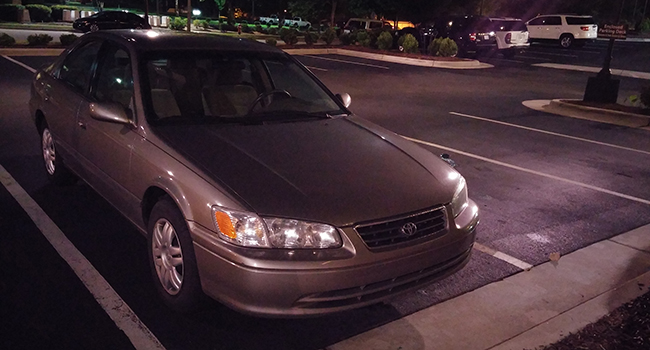
The performance difference is less in favor of the G3 in this shot but overall performance is still better than the Galaxy S5.
Outdoor Scenes (Daylight)
We ran through a new set of locations on the four main Android shooters here. I've pulled out one of the best comparisons below:

The G3's color handling is so much better than on the G2. The latter has more of a blue overcast while the G3's image looks much more natural. The Galaxy S5 by comparison is appreciably sharper (look at the detail in the speed limit sign in the background).
Capture Latency
LG, HTC and Samsung all went to great lengths this generation to reduce focus acquisition latency on their flagships. I believe HTC is partially leveraging its DuoCam sensor as well as a secondary ISP, Samsung turned to Phase Detect AF and a secondary ISP, while LG looked to an IR range finder to help speed up focus acquisition. We've been measuring focus latency over the past few flagship reviews and put the G3 through the same test. Here I used the same ISO 12233 target setup we used for spatial resolution tests but measured average focus acquisition time for a number of points on the chart.
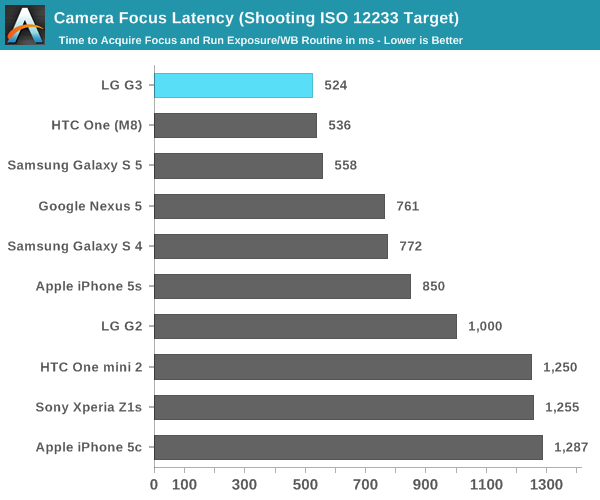
The G3's performance is so much better than the G2, you can grab focus in around half the time now. Compared to the M8 and GS5, the G3 is perhaps a bit quicker. I measured lower minimum focus acquisition time on the G3 than on either flagship, but on average the performance is quite similar to what HTC and Samsung deliver - at least in this test.
Quickly acquiring focus is just one aspect of overall camera latency. How quickly the device can actually capture an image is almost as important. Here we're looking at the time between tapping the shutter button and when the camera UI is responsive again (this is how all devices in this chart, with the exception of the One mini 2, are measured). Another metric that's useful in looking at is how long before the resulting photo is available in the gallery, for the G3 I've included both datapoints. The One mini 2's data corresponds to the latter metric exclusively as the camera UI behaves as if it's immediately responsive after capture but in reality isn't.
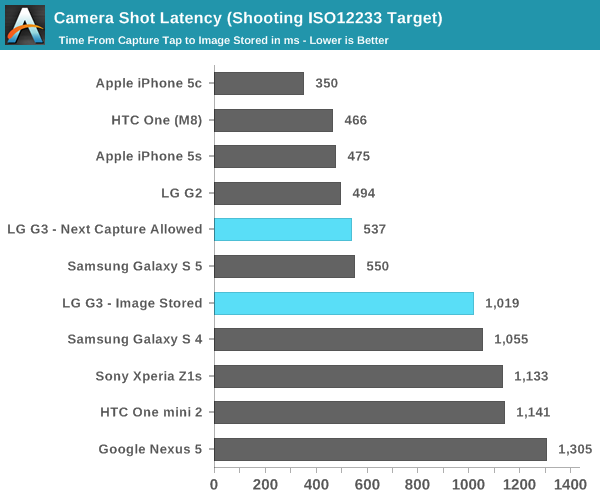
The G3 seems to regress a bit compared to the G2 but overall its peak performance looks decent. If you want immediate access to the captured image you will have to wait about a second, but in reality by the time you tap on the captured image and pull up the gallery you'll exceed this 1019ms latency. Bringing up the gallery is definitely the bottleneck here.
This next chart simply adds the previous two numbers together to provide a look at total camera latency:
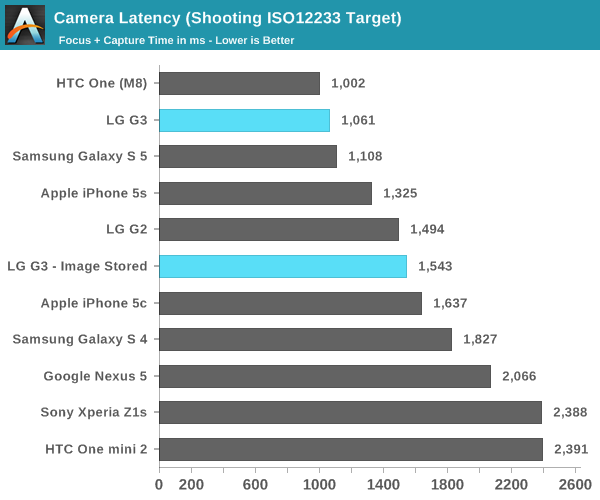
The G3 is quite competitive with the 2014 Android flagships when it comes to overall camera latency. The improvement compared to the G2 is substantial.
Video
The G3 can shoot 4K video at 30 fps and it does so at roughly 30Mbps, up from 20Mbps when shooting 1080p30 video. I included a couple of samples that also engage the device's OIS+:






















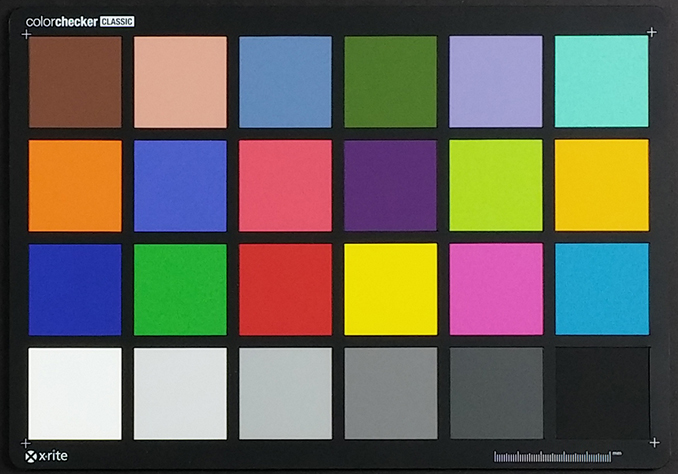






























































174 Comments
View All Comments
akdj - Sunday, July 13, 2014 - link
"...and sure in the heck are not paying $60 for a stupid case for that."That made me laugh. You're unwilling to throw down $60 on a case while 'considering' dropping/dumping or upgrading from one of today's 'Flagship' phones! Thanks though for the Sunday chuckle but WOW. Color me silly, but that's a helluva 'first world' challenge you've got going there! Anand posted an(other) excellent, well written review. Another flagship handset. Innovative display and yep...as so many others before you have mentioned... All at the expense of a bit of brightness (typically a 'non issue' as we use our phones most often indoors, and outdoors the measurements are still just 'fine' for usage & snapshots), wireless charging? Really, you're basing your purchase decision on an unproven, completely niche and rare...without common specification technology? I own a Note 3 & an iPhone 5s. The former, solely for my business. The latter, my personal phone. I love them both and honestly feel like we've hit that 'plateau' in performance. Almost a year in, I'm wondering if I'll even take advantage of the NEXT deal at AT&T. They're both still fast as hell, no way I'd notice any differences between those and today's offerings (iPhone TBD, obviously) from Android. While Sammy has improved its AMOLED technology in the S5 even more than the S4-->Note 3, I've used both and honestly, even as an almost three decade professional audio and video production company business owner and operator, the differences to me were hardly distinguishable. They've come a LONG way with AMOLED in comparison to the long time king of displays, the LCD, to the extent in many (possibly more than) measurements, it's taken over as the 'better' technology. Longevity? We're yet to see, but without Samsung innovating their technology, and listening to the detractors...or paying attention to reviews, numbers and measurements each generation, they'd have 'pulled out'. You've got a damn sweet phone NOW. There's not a single phone available today that's going to 'better' your M8 if you bought it knowing its strengths, and more importantly it's limitations. If you're looking for the all around 'best' camera, you made the wrong choice. If you take few photos or primarily shoot in low light situations ...you made the right choice. Hard to bitch about HTC's UI. It's excellent! While I'm one of the very few that actually 'like' T/W, you're probably best taking my GUI opinion with a grain of salt but other than your issue with contrast (valid complaint, IMHO as a 'visual geek'), I know I took a long time to get to the point, so ....
Tl/Dr, that's silly. Don't even THINK about replacing your M8 today. Unless you're A) still within the 'return period' and/or
B) not happy with the phone for some reason (why did you buy it? It's a bad ass hand set! Don't 'chase' specs, the genesis of technologies or 'absolutes' when it comes to a 'smartphone' --- in the end, you'll be underwhelmed, disappointed and you'll lose money EVERY time you do something so 'silly')
Ultimately today's smartphone market is awesome. With over two million apps between iOS and Android, Windows making their own moves (& certainly, while late to the game with the SP3, ousting of Balmer, and it's iOS MS Office suite 1.0 release...Win 365 subscription family package @ $10/month for five tabs and five computers and five users, EACH with a TB of their own storage accessible via OneNote from anywhere, anytime, GRAND SLAM! Go to Best Buy and save $40 for the year, about every other week they've got the bundle on sale...& it's completely 'cross platform' with an Android full release imminent, I'm an OSx user primarily but also own a pair of Windows machines. As well, being a Note 3 user, I'm very excited to see where MS is going...)
Yep. LG took a leap at this resolution. But they're one of very few display manufacturers. Most OEMs use Samsung, LG, or Sharp displays. Makes sense to me at least they'd be the ones aiming for the 'ultimate' resolution for human visual acuity. Is THIS the version to buy? If you're an original LG 'g1' owner, maybe switching out of an S3 contract, or not exactly crazy any longer with iOS and considering upgrading a 4s or iPhone 5 that you purchased almost two years ago, ABSOLUTELY! If you're an owner of a 2013 flagship, either iOS or Android, from those measurements (other than PPI/display technology and size preference), it's very obvious 2014 to this point had been 'iterative' with refinements to UIs (Samsung has definitely worked in TouchWiz instead of adding 'more' they've refined existing features, ala S-Pen/features and it's recognition when the pen is out ... Better overall ability to 'control' the OEM's pre-installed software (carrier bloat, different story but ubiquitous regardless of Android choice) -- point being they've succeeded with UI improvements and that's a BIG end user 'upgrade' IMHO. While the UI needs a refresh, a launcher of choice is a simple and cheap addition. The A7 hit Qualcomm like a ton of bricks. While indeed Apple is still a ways away from utilizing its full power due to RAM, the A8 instruction set, new memory management and the 7.1 'update' were HUGE. Obviously still keeping computational pace with significantly 'faster' clock speeds on half the cores with half the memory. As well - the dated IT graphics solution Apple used on the A7 will certainly be updated on the A8. Qualcomm will be ready with 64bit SOCs next year, or late this year. I guess my question would be 'why' HTC, Samsung, and LG aren't using the faster 805/420s today? Sorry to ramble but ultimately, I'm extremely excited to see this type of evolutionary improvement from one of today's largest display manufacturers. I'm glad to see the transition from '3D' to HiDPI from the 2011/12/13 CES shows to the '4K' and HiDPI displays shown off this past January in Vegas, and actually 'affordable' 1.0 releases @ Best Buy half way through '14. IMHO, display resolution rules the roost. With resolution, comes ALL the primary factors that make ANY resolution 'good' vs 'great". Attributes that come FAR before resolution updates, you're correct ...kind of. Brightness while important, especially in a cell phone is pretty important. Though as you can plainly see, it's still 'good' and easily visible outdoors. Contrast = Huge. Color and gamut/calibration as well as grey scale, gamma, display technology used, viewing angles, saturation and 'response time'. If you're gaming, you're looking for fast refresh rates, you'd hate my new Eizo. Soooo many factors that go into a good display and they're each (OEMs) beginning to 'get it'. Pre sale calibration. Options for, albeit limited post purchase calibration (TouchWiz and the display adaption option). Pushing barriers is good. My dream is to have 4k displays and a delivery system for the content in place by 2020. HiDPI displays are ubiquitous on computing displays. (Hard to explain my passion and 're' invigoration for using my computer, my laptop ...daily, since purchasing my first rMBP in 2012. We've now got seven, five for the business, two personal 15" 2013 rockets! PCIe TB storage that is faster than anything I've used in my life, a display that blows my mind EVERY time I turn it 'on' ...its I/O options, TB2 has become a GodSend for us, as have the new docks and the ability to literally turn it into a 'desktop' workstation (- the Xeon procs and enterprise RAM, you'd never know. It's truly THAT fast!)). I could go on and on but I guess I'm blown away by the 'reasons' some folks come up with to not replace their five month old bad ass pocket computer. Nor do I understand the backlash from our 'geek' community against LG for pushing the barriers AND using scientific reasoning to explain human visual acuity, how much density is 'truly' necessary to be indistinguishable from the sharpest photo, the finest print (especially for many traditional Asian writing/text/characters and alphabets)... Or and while I so hate the cliche itself; "Like looking through a window" ...IOW, his explanation was pertaining to the ability to 'see' in a display the 'same' visually your eye would see in a 'real world' scenario.
Again, all my opinion. Yours is different, I respect that. But I don't respect spec chasing, bullshit reasons to upgrade every three months to chase specs and bragging rights. That's dumb. It's not what you make, it's what you save. From your comment, I'm assuming your young (ya know what they say about assumption though). If I'm wrong, I'm sorry. If I'm correct, the difference in you saving that extra three to six hundred a year you're dropping on cell phones when you're 30, 40, 50...65 and ready to retire, is HUGE! Say you're 25. Without interest, that's $12-$24,000. With that cash each year and another $150/month stashed away starting at 20 instead of thirty in a fund that nets you an 8% average yearly increase (over 40 years) is 3.9 million @20 vs 2.2 million at 30 years old. At 40, you'll be lucky to hit a million. Figure out today what tomorrows 'Apple' stock will be and throw all that out the window. Buy all ya can and sell in a decade. You and the next six generations of your family won't have to work ;)
anishannayya - Tuesday, July 15, 2014 - link
No one has the time or energy to read your massive wall of text...tenaciousjesse - Tuesday, July 29, 2014 - link
Wow. You may have priceless knowledge. U DO ramble, but it's not just random idiotic rambling. Email me-jesse30135@Gmail.comsoldier4343 - Thursday, July 17, 2014 - link
Ignorant.TechShark - Monday, November 17, 2014 - link
I have a Sprint US G3 and the screen is super bright and colors seem very close to my iphone 6. I actually prefer the G3 display. I've heard that LG tweaked the display for the US version of the phone after some of the brightness and calibration criticisms about the Korean model such as was reviewed here. In fact on reviewer said he thought it might be a different panel altogether. Maybe Anandtech can look into this and see if recent US spec G3 models are in fact getting an improved display because mine is simple gorgeous and very bright.soldier4343 - Thursday, July 17, 2014 - link
Having the top of the line is all about bragging rights over actual benefit of a higher resolution.vr4africa - Friday, May 1, 2015 - link
I do not agree, with VR becoming big, I for one are big fan of VR, you need at least a 1440p screen. For proper VR you actually need a 4k screen. That is one of the reasons LG has pushed for the 2k screen. So if you were living under a rock the last 2 years and do not even know about VR, you should not make comments and judgement!hughlle - Friday, July 4, 2014 - link
And how do you arrive at that conclusion? It is stomped over by the G2 in the majority of the battery life tests.cylemmulo - Friday, July 4, 2014 - link
did you mix up the words G3 and G2?ASEdouard - Saturday, July 5, 2014 - link
I don't know. Brightness/viewing angles in a photo display is very important to me. I'd take that over the higher pixel count. I think I actually like the G2 better than the G3.